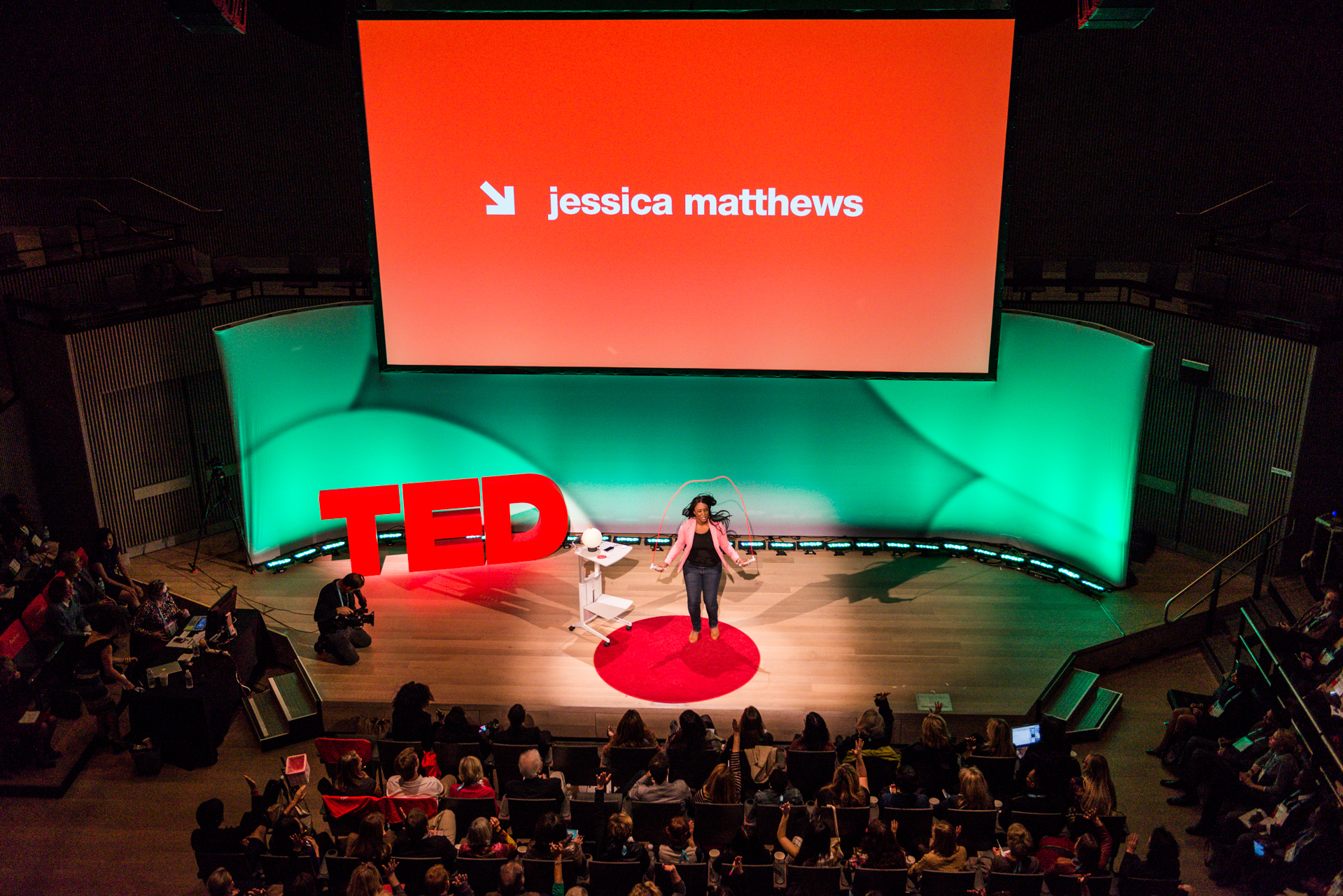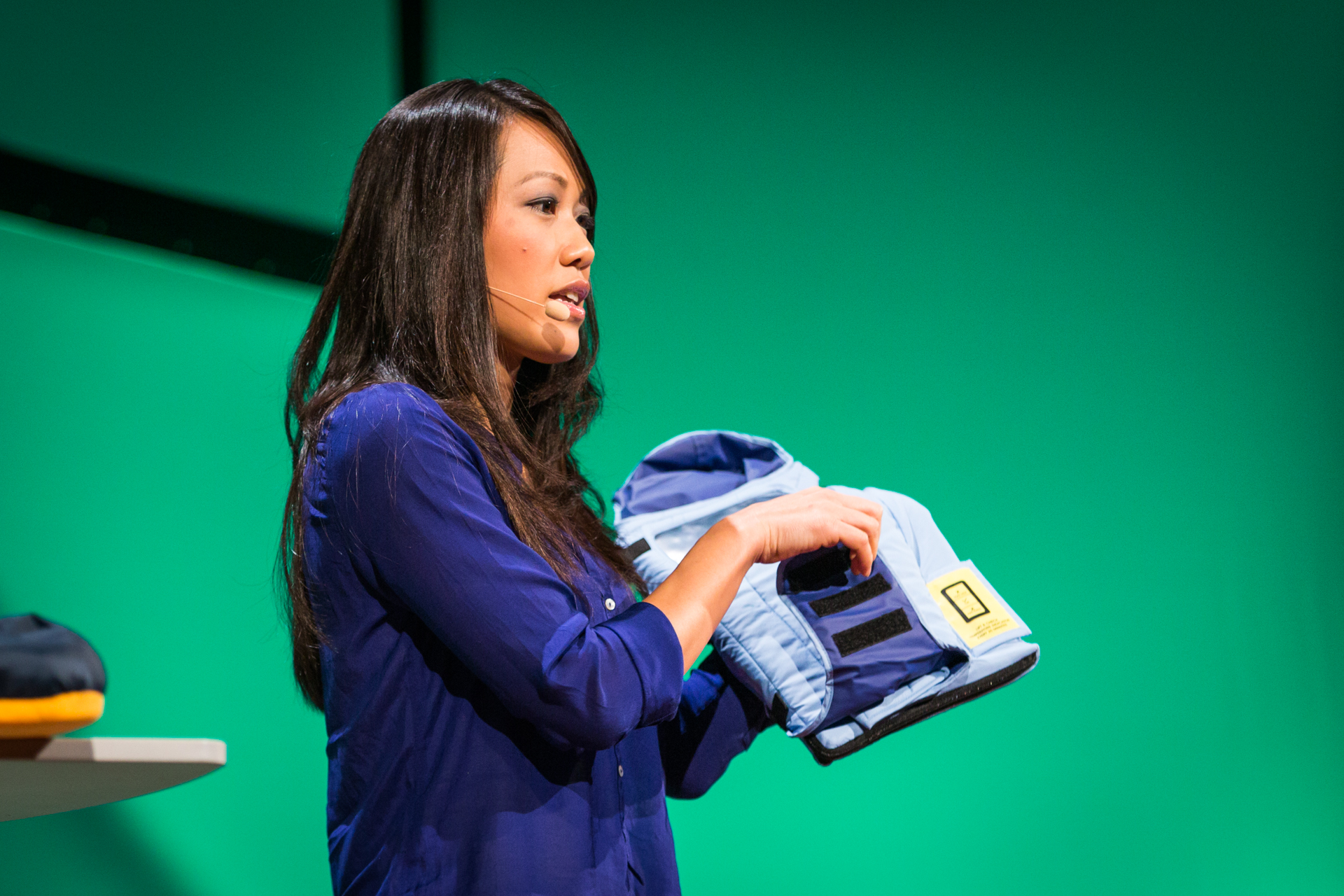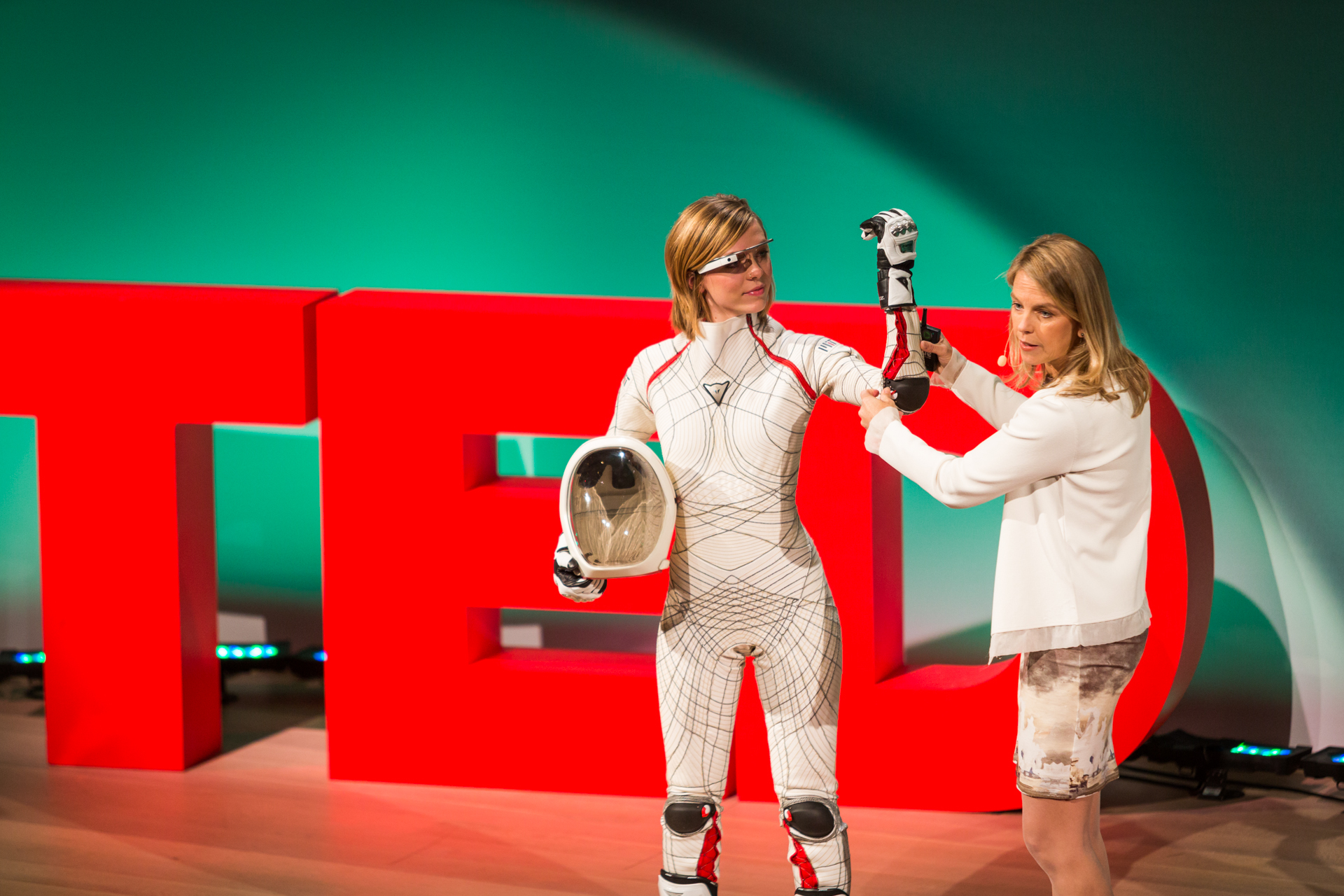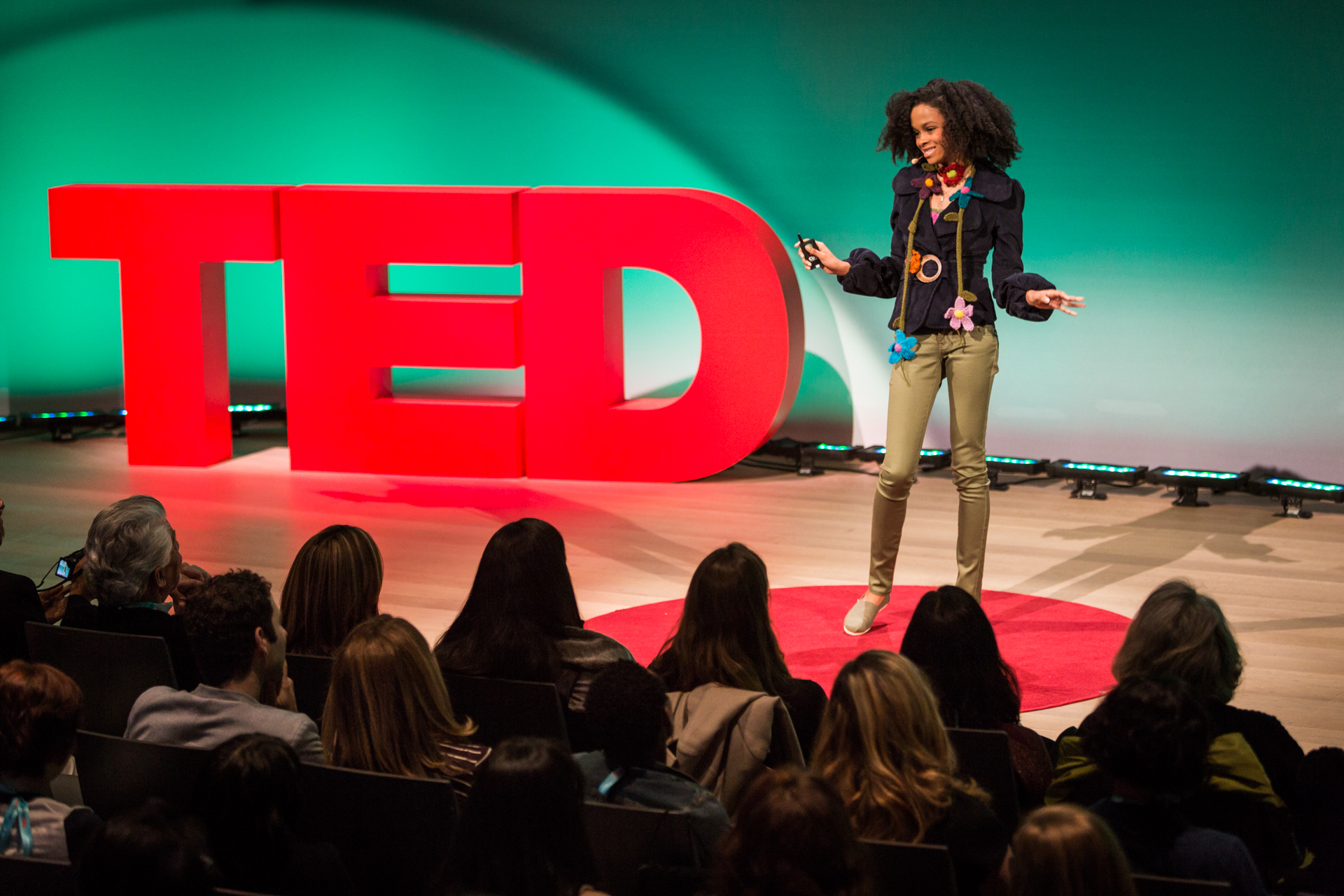
Jessica Matthews demonstrates her power-generating jumprope. Photo: Kristoffer Heacox
By Becky Chung and Emily McManus
The SF Jazz theater fills with the beeping and plinking sounds of a cellphone. Bora Yoon, a TED Fellow and experimental musician who weaves found sounds from old and new technologies, is on stage surrounded by her instruments: a golden flowered gramophone horn, a mixer, a computer and her phone. The cellphone sounds ebb and flow, and repeat and evolve as she adds layers and layers of her voice. The effect is a haunting choral soundscape that transforms the room into a church from an alternate universe.
It’s an ethereal intro to TEDWomen 2013, themed “Invented Here.” To kick off the first session of the event, “To Be is To Do,” hosts Pat Mitchell of the Paley Center and June Cohen of TED Media begin by sharing just a few of the things that women have invented: for example, windshield wipers, the first solar house, disposable diapers and one of the first computers.
Below, read a recap of the speakers who followed in session 1:
Jessica Matthews kicks off her talk, almost literally, with a few sporty rounds of jumprope. (In heels!) After she lands, she holds up the rather large handles of her jumprope, snaps in an adapter — and charges her phone. Yes, her 15 quick jumps were generating electricity. Pulse is the latest product from Jessica Matthews and co-founder Julia Silverman’s company, Uncharted Play. Their first product was actually dreamed up in a junior-year class on engineering for non-engineeers, where they two students combined a social problem — lack of electricity in small villages around the world — and a universal truth — that kids around the world love to kick a soccer ball. They came up with a brilliant idea: What if a soccer ball could generate electricity? The sOccket ball can create about 3 hours of light from an LED after 30 minutes of playing. It weighs just about 2 ounces more than a standard ball and powers a few hours of post-play homework, cutting down on the use of kerosene and other fuels in the home. Onstage, Matthews snaps a 3-LED lamp into her soccer ball, drawing ahhhs. So what inspires her? Well, first, her mom, born in Nigeria (and as Matthews says, “‘tiger moms’ have nothing on Nigerian moms!”). Her mom pressed her to invent, to build and create. And it led Matthews to the idea of the “domino innovation” — a simple insight that leads to another, and another, and another. As she says: “Domino innovations are not about the product or systems themselves, but about the people they end up inventing.”
“How do you ensure technology reaches the users that need it?” asks Krista Donaldson, CEO of D-Rev, a nonprofit dedicated to design solutions for those without a lot of money. One of the projects she and her team have been working on is reMotion, a low-cost polycentric knee replacement for above-the-knee amputees. This knee works fantastically and costs just $80. And this is big because there are over 3 million amputees every year who need a replacement knee and — before reMotion came into the picture — the options available ranged from an advanced $20,000 knee piece with a microprocessor to a $105 “low-end” knee replacement which gave the user a movability of door hinge. While iterating reMotion prototypes, Donaldson says she learned a few key lessons: that to have impact, a product needs to be world-class, its design needs to user centric and meet the demands of the market. Today, the reMotion knee is worn in 12 countries by about 5,122 amputees. In terms of lasting power — which is measured by if a user is using the product 6 months later — their average is 79%.

Jane Chen shows the latest version of the Embrace warmer, which can help mothers in developing nations save low-birth-weight babies. Photo: Marla Aufmuth
Five years ago, Jane Chen launched the Embrace baby warmer after a simple, devastating insight: She met an Indian woman who had lost not one but three prematurely-born babies, because of the lack of money to access a hospital with an incubator to help her tiny babies regulate their temperature. So Chen, a TED Fellow, and her team took the next year to create a simple, easy-to-use baby warmer for hospitals. She spoke about this at TEDIndia in 2009. But since, Chen has had a bigger insight: We need to make the Embrace more usable for moms themselves. Because, as she says, “a mother will do anything to save her child.” She talks us through the small but vital hacks that make the new Embrace warmer easy to use — even for women who cannot read — thanks to simplified and smartened-up directions. Her research shows: This has worked. All the moms got how to use the device. As she says: “Tech alone can’t change the world. Tech powered by love can.”
When Dame Stephanie “Steve” Shirley lost her voice this morning, Megan Smith — Google[x]’s Vice President — bravely stepped in with only an hour’s notice to save the talk. Why? Because Smith was the one who found Shirley and suggested her for the TEDWomen stage. Smith came across Shirley on a work trip to the UK, when she found herself face-to-face with a portrait of Ada Lovelace — the 1st programmer in the world and “our founder.” It got Smith thinking about the lost history of technical women. Smith reminded us other female greats such as inventor Hedy Lamarr, creator of “debugging,” and encouraged the audience to remember the stories of their techy foremothers. One of them being Shirley. And with that, Smith played a short documentary she created about Shirley, which you can watch here. A short recap: When Shirley found herself hitting the glass ceiling in 1962, she gave her notice and left to start her own software company — a company made up of and driven by women. For 13 years, it remained a women’s company. Of course, when equal opportunity legislation came it meant the company had to start employing men. “We did start letting in the men, as long as they were good enough,” she says with a wink. In 1966, the company floated on the London stock exchange making an astounding 17 of its female employees into millionaires.
Next up: Maya Penn, who starts off her talk by playing two of her wonderful animations — a café where viruses hang out; a squad of eco crime fighters — and then bubbles up onstage to talk about everything else she loves to do too: fashion, technology, business, philanthropy. And yes, she’s just 13. Wearing a fabulous knitted scarf from her line, she talks about how she became such a young businessperson. “I didn’t have a business plan, because I was only 8 years old,” she says — but she set some big, simple goals: “All of my items had to be eco-friendly, and 10 to 20% of the profits I made had to go to environmental organizations.” Why? “Because we live in a big, beautiful, diverse world and that makes me even more passionate to save it.”
Diana Nyad has been on quite a few epic journeys — this year, she successfully swam from Cuba to Florida after four previous attempts, beginning in 1978. Today, she talks about the most epic journey of them all: life. “If you believe in perseverance as a great human quality, you find your way,” she says. An example of her unrelenting perseverance? At night, she had to swim in the pitch dark because any light would attract poisonous jellyfish and sharks. Oh right, forgot to say: She didn’t wear a shark cage. Nyad listened to John Lennon’s “Imagine” at least a thousand times as she kept swimming. At her worst, when she was vomiting from too much salt water and losing weight drastically, she comically recalls seeing a vision of the Taj Mahal. The journey was 110 miles long and took 53 hours, but she made it — at age 64. “When I turned 60, it wasn’t about the athletic accomplishment or the ego of ‘I want to be the first,’ it was deeper,” she says. “It was how much life is left.” Finally, she says, although long-distance swimming looks like a solitary endeavor, it’s really a team effort. “The team is expert and the team is courageous and brimming with innovation and scientific discovery,” she says.

Behold, a slim-fitting spacesuit to let astronauts move in space. Scientist Dava Newman, left, demonstrates on model Deborah Auda. Photo: Marla Aufmuth
MIT professor Dava J. Newman has the coolest job in the world: “I am a rocket scientist!” She’s an expert in biomechanics who developed a slim-fitting compression suit, called the BioSuit, to help astronauts get around more easily in space. Think of a spacesuit, she says, as a very tiny spacecraft — the ultimate protection for the human body in space. The current versions of spacesuits are basically tin cans, heavy and slow (as she demonstrates with a blooper reel of astronauts stumbling on the moon). Astronauts who train in these suits now, she says, have undergone some 25 shoulder surgeries related to the heavy side bearing in the suit. She asks: How can we protect the astronaut’s body better? She builds skintight pressure suits that play off the body’s own internal structures to create 20 to 30 percent of the atmospheric pressure required to protect the body. Model Deborah Auda steps onstage to demonstrate, in an elegant suit marked with lines of extension and pressure. (See our Instagram photo.) Such pressure suits may also help kids here on Earth with cerebral palsy gain mobility. And — very, very big picture — Newman suggests that better spacesuits will help us reach the next space frontier: sending human astronauts to Mars, to discover whether life ever existed there. As she says: “I want all of your energy to go into exploring Mars, not overcoming your bulky spacesuit.”

Comments (28)
Pingback: This New Form-Fitting Spacesuit Could Revolutionize How Astronauts Move In Space | Bamboo Innovator
Pingback: Mother knows best: Re-making the Embrace baby warmer for moms | BizBox B2B Social Site
Pingback: Mother knows best: Re-making the Embrace baby warmer for moms | Best Science News
Pingback: This New Form-Fitting Spacesuit Could Revolutionize How Astronauts Move In Space | Content Loop
Pingback: This New Form-Fitting Spacesuit Could Revolutionize How Astronauts Move In Space | This Is Jah Smith DOT com
Pingback: This New Form-Fitting Spacesuit Could Revolutionize How Astronauts Move In Space | Digital Wealth
Pingback: This New Form-Fitting Spacesuit Could Revolutionize How Astronauts Move In Space | [ mukeshbalani.com ]
Pingback: TEDWomen 2013 « Colgate Women in Business
Pingback: The highlights of TEDWomen 2013, in pictures | Best Science News
Pingback: The highlights of TEDWomen 2013, in pictures | BizBox B2B Social Site
Pingback: The highlights of TEDWomen 2013, in pictures | Daily News Stack
Pingback: New Space Suit Designs Are Less NASA, More Mass Effect
Pingback: Bora Yoon: 2014 TED Fellow | Sozo Media
Pingback: TEDxWomen: Invented Here | HerCanberra
Pingback: Space-for-All at HobbySpace » Dava Newman and her Bio-Suits for EVA + Automating space farming
Pingback: A power-generating jumprope, a sexy spacesuit and a swim from Cuba to Florida: A recap of TEDWomen 2013 session 1
Pingback: TEDWomen događaj ili priče čiji je okvir usklađen sa stavom | PRototip